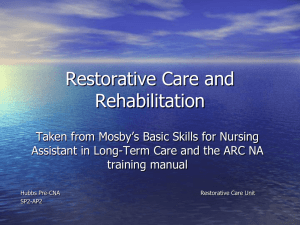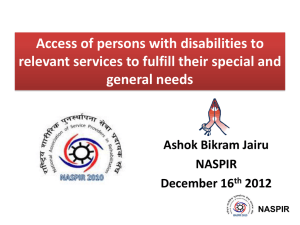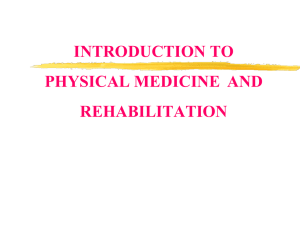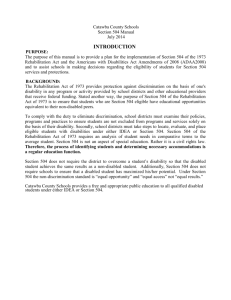orca references/resources - Oregon Counseling Association
advertisement
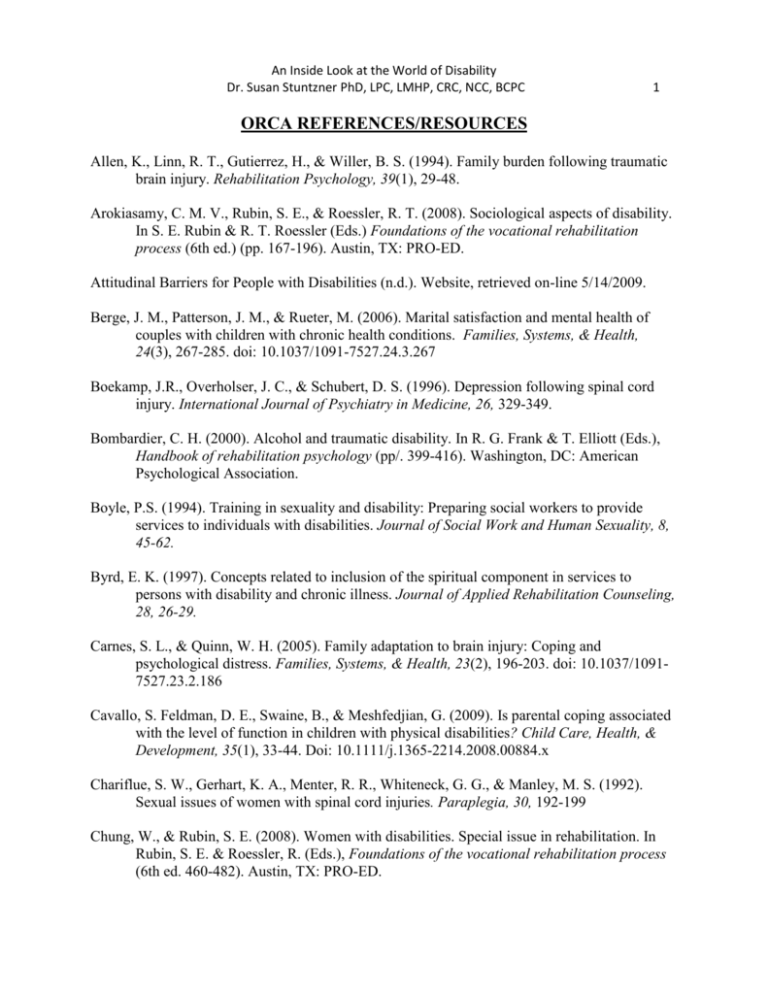
An Inside Look at the World of Disability Dr. Susan Stuntzner PhD, LPC, LMHP, CRC, NCC, BCPC 1 ORCA REFERENCES/RESOURCES Allen, K., Linn, R. T., Gutierrez, H., & Willer, B. S. (1994). Family burden following traumatic brain injury. Rehabilitation Psychology, 39(1), 29-48. Arokiasamy, C. M. V., Rubin, S. E., & Roessler, R. T. (2008). Sociological aspects of disability. In S. E. Rubin & R. T. Roessler (Eds.) Foundations of the vocational rehabilitation process (6th ed.) (pp. 167-196). Austin, TX: PRO-ED. Attitudinal Barriers for People with Disabilities (n.d.). Website, retrieved on-line 5/14/2009. Berge, J. M., Patterson, J. M., & Rueter, M. (2006). Marital satisfaction and mental health of couples with children with chronic health conditions. Families, Systems, & Health, 24(3), 267-285. doi: 10.1037/1091-7527.24.3.267 Boekamp, J.R., Overholser, J. C., & Schubert, D. S. (1996). Depression following spinal cord injury. International Journal of Psychiatry in Medicine, 26, 329-349. Bombardier, C. H. (2000). Alcohol and traumatic disability. In R. G. Frank & T. Elliott (Eds.), Handbook of rehabilitation psychology (pp/. 399-416). Washington, DC: American Psychological Association. Boyle, P.S. (1994). Training in sexuality and disability: Preparing social workers to provide services to individuals with disabilities. Journal of Social Work and Human Sexuality, 8, 45-62. Byrd, E. K. (1997). Concepts related to inclusion of the spiritual component in services to persons with disability and chronic illness. Journal of Applied Rehabilitation Counseling, 28, 26-29. Carnes, S. L., & Quinn, W. H. (2005). Family adaptation to brain injury: Coping and psychological distress. Families, Systems, & Health, 23(2), 196-203. doi: 10.1037/10917527.23.2.186 Cavallo, S. Feldman, D. E., Swaine, B., & Meshfedjian, G. (2009). Is parental coping associated with the level of function in children with physical disabilities? Child Care, Health, & Development, 35(1), 33-44. Doi: 10.1111/j.1365-2214.2008.00884.x Chariflue, S. W., Gerhart, K. A., Menter, R. R., Whiteneck, G. G., & Manley, M. S. (1992). Sexual issues of women with spinal cord injuries. Paraplegia, 30, 192-199 Chung, W., & Rubin, S. E. (2008). Women with disabilities. Special issue in rehabilitation. In Rubin, S. E. & Roessler, R. (Eds.), Foundations of the vocational rehabilitation process (6th ed. 460-482). Austin, TX: PRO-ED. An Inside Look at the World of Disability Dr. Susan Stuntzner PhD, LPC, LMHP, CRC, NCC, BCPC 2 Crewe, N. M., Athelstan, G. T., & Krumberger, J. (1979). Spinal cord injury: A comparison of pre-injury and post-injury marriages. Archives of Physical Medicine & Rehabilitation, 60, 252-256. Cushman, L. A., & Dijker, M. (1991). Depressed mood during rehabilitation of persons with spinal cord injury. Journal of Rehabilitation, 57, 35-38. De Loach, C. (1994). Attitudes toward disabilities: Impact on sexual development and forging of intimate relationships. Journal of Applied Rehabilitation Counseling, 25, 18-25. Dunn, D. S., Uswatte, G., & Elliott, T. R. (2009). Happiness, resilience, and positive growth following physical disability: Issues for understanding, research, and therapeutic intervention. In S. Lopez & C.R. Snyders (Eds.), Oxford handbook of positive psychology (2nd ed.) (pp. 651-664). New York, NY: Oxford University Press. Elliott, T. R., Kurylo, M., Chen, Y., &^ Hicken, B. (2002). Alcohol abuse history and adjustment following spinal cord injury. Rehabilitation Psychology, 47, 278-290. Gill, C. J. (1996). Dating and relationship issues. Sexuality & Disability, 14(3), 183-190. Gisi, T.M., & D’amato, R. C. (2000). What factors should be considered in rehabilitation: Are anger, social desirability, and forgiveness related in adults with traumatic brain injury? International Journal of Neuroscience, 105, 121-135. Glover-Graf, N. M., Marini, I., Baker, J., & Buck, T. (2007). Religious and spiritual beliefs and practices of persons with chronic pain. Rehabilitation Counseling Bulletin, 51(1), 21-33. Henker, F. O. (1979). Body-image conflict following trauma and surgery. Psychosomatics, 20, 812-820. Johnston, B. (1982). Pregnancy and childbirth in women with spinal cord injuries: A review of the literature. Maternity Child Nursing Journal, 11, 41-46. Juergen, M. H., Miller-Smedema, S., & Berven, N. L. (2009). Willingness of graduate students in rehabilitation counseling to discuss sexuality with clients. Rehabilitation Counseling Bulletin,53(1), 34-43. doi: 10.1177/0034355209340587 Kazukauska, K. A., & Lam, C. S. (2009). Disability and sexuality: Knowledge, attitudes, and level of comfort among Certified Rehabilitation Counselors. Rehabilitation Counseling Bulletin, 54(1), 15-25. doi: 10.1177/0034355209348239 Kilpatrick, S. D., & McCullough, M. E. (1999). Religion and spirituality in rehabilitation psychology. Rehabilitation Psychology, 44(4), 388-402. An Inside Look at the World of Disability Dr. Susan Stuntzner PhD, LPC, LMHP, CRC, NCC, BCPC 3 Langer, K. G. (1994). Depression and denial in psychotherapy of persons with disabilities. American Journal of Psychotherapy, 48(2), 181-194. Livneh, H. (2001). Psychosocial adaptation to chronic illness and disability. Rehabilitation Counseling Bulletin, 44, 151-160. Livneh, H., & Antonak, R. F. (1997). Psychosocial adaptation to chronic illness and disability. Gaithersburg, MA: Aspen Publishing. Livneh, H., & Antonak, R. F. (1994). Psychosocial reactions to disability: A review and critique of the literature. Critical Reviews in Physical and Rehabilitation Medicine, 6, 1-100. Longo, D. A., & Peterson, S. M. (2002). The role of spirituality in psychosocial rehabilitation. Psychiatric Rehabilitation Journal, 25, 333-340. Mackelprang, R. W. (1991). Neither hero nor service project: Developing healthy attitudes toward people with disabilities. Paper presented at the 1989 Northwest Sunstone Symposium. Retrieved on-line May 14, 2009. Noonan, B. M., Gallor, S. M., Hensler-McGinnis, N. F., Fassinger, R. E., Wang, S., & Goodman, J. (2004). Challenge and success: A qualitative study of the career development of highly achieving women with physical and sensory disabilities. Journal of Counseling Psychology, 51(1), 68-80. doi: 10.1037/0022-0167.51.1.68 Nosek, M. A., & Hughes, R. B. (2003). Psychosocial issues of women with physical disabilities: The continuing gender debate. Rehabilitation Counseling Bulletin, 46, 224-233. Olkin, R. (1999). What psychotherapists should know about disability. New York: Guildford Press. Olkin, R. (2008). Women with disabilities. In J. C. Chrisler, C. Golden, & P. D. Rozee (Eds.) Lectures on the psychology of women (4th ed) (pp. 191-203). New York: McGraw-Hill. Park, C. L. (2010). Making sense of the meaning literature: An integrative review of meaning making and its effects on adjustment to stressful life events. Psychological Bulletin, 136(2), 257-301. Doi: 10.1037/a0018301 Reichman, N. E., Corman, H., & Noonan, K. (2008). Impact of child disability on the family. Maternal and Child Health Journal, 12, 679-683. doi: 10.1007/s10995-0070307-z Rubin, S.E., & Roessler, R. T. (2008). Foundations of the vocational rehabilitation process (6th ed.). Austin, TX: PRO-ED. An Inside Look at the World of Disability Dr. Susan Stuntzner PhD, LPC, LMHP, CRC, NCC, BCPC 4 Scofield, M. E., Pape, McCracken, N., & Maki, D. R. (1980). An ecological model for promoting acceptance of disability. Journal of Applied Rehabilitation Counseling, 11, 183-187. Siller, J., Chipman, A., Ferguson, L. T., & Vann, D. (1967). Attitudes of the nondisabled toward the physically disabled. In J. Siller & K. R. Thomas (1995), Essays and research on disability (pp. 21-30). Athens, GA: Elliott & Fitzpatrick. Smart, J. (2009). Disability, society, and the individual (2nd ed.). Austin, TX: PRO-ED. Stuntzner, S. (2008). Comparison of two self-study on-line interventions to promote psychological well-being in people with spinal cord injury: A forgiveness intervention and a coping effectively with spinal cord injury intervention. (Doctoral dissertation, University of Wisconsin-Madison, 2007). Dissertation Abstracts International. Stuntzner, S. (2012). Living with a disability: Finding peace amidst the storm. Counseling Association of India. Stuntzner, S. (in press). Resiliency and coping: The family after. Counseling Association of India. Stuntzner, S., & Hartley, M. (2013). Balancing self-compassion with self-advocacy: A new approach for persons with disabilities to enhance their process of learning to selfadvocate. Manuscript submitted for publication. Trieschmann, R. (1988). Spinal cord injuries: Psychological, social, and vocational rehabilitation (2nd ed.). New York: Demos. Westgren, N. & Levi, R. (1999). Sexuality after injury: Interviews with women after traumatic spinal cord injury. Sexuality & Disability, 17(4), 309-319. White, B., Driver, S., & Warren, A. M. (2008). Considering resilience in the rehabilitation of people with traumatic disabilities. Rehabilitation Psychology, 53(1), 9-17. doi: 10.1037/0090-5550.53.1.9 White, B., Driver, S., & Warren, A. M. (2010). Resilience and indicators of adjustment during rehabilitation from a spinal cord injury. Rehabilitation Psychology, 55(1), 23-32. doi: 10.1037/a0018451 White-Means, S. L. (1997). The demands of persons with disabilities for home health care and the economic consequences for informal caregivers. Social Science Quarterly, 78(4), 955-972. Wright, B. (1983). Physical disability: A psychosocial approach. Elmsford, NY: Permagon.

